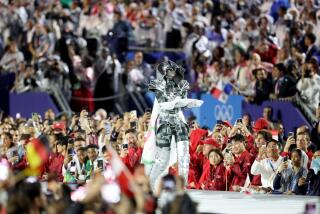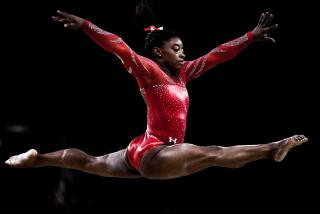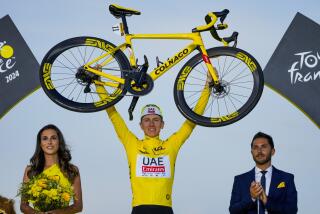Tour de France Trying to Outdistance Its Recent Trials
- Share via
LE PUY DU FOU, France — When, at 4:10 p.m. Saturday, Carlos Da Cruz put his freshly shaved legs on the pedals of a matte-gold bicycle, France’s greatest summer event and ritual, trying to battle back from its worst crisis, got underway again.
Over the decades, the Tour de France cycling race has grown into a unique hybrid of sporting exploit, national bonding experience and orgy of commercial hucksterism. But the Tour, along with professional cycling as a whole, has been devastated by a series of doping scandals and whether, coincidentally or not, this Tour’s 180-competitor field is devoid of past winners for the first time in decades.
If this were an earlier summer, all of France, and millions of television viewers in 165 countries, would follow with rapt attention as over three grueling weeks, through sunbaked wheat fields and cold, befogged Alps, the cyclists pump along a clockwise, 2,288-mile loop, ending July 25 with 10 laps on the Champs-Elysees in Paris.
But this is no typical year and this no normal Tour. One Paris newspaper scornfully dismissed this race, the 86th, as the “Tour de Farce.”
Two weeks ago, the event’s director, Jean-Marie Leblanc, visited a chapel in southwestern France hung with the jerseys of past cycling champions and prayed for the success of the most prestigious event of its kind.
“For 12 months, I’ve been going through up and down periods,” Leblanc said. “There are moments when I believe we’re on the right path, that cycling and the Tour have won. There are other moments where doubt returns.”
The nightmare began last year, when the Tour was rocked by police raids, protest strikes by riders and a flurry of disqualifications of competitors found to have used illegal performance-enhancing substances.
This June, the winner of the 1998 Tour, Marco Pantani of Italy, was ejected from his own country’s top endurance race, the Giro, which he was leading by more than five minutes, after a blood test revealed him to have a suspiciously high level of red cells.
The test Pantani flunked is technically not a drug test, but it hints at the use of an illegal, still undetectable performance-enhancing hormone, EPO, which promotes the growth of red blood cells, and thus the amount of oxygen carried to muscles.
Analyses have shown that a rider using EPO can add 2 1/2 mph to his speed--an enormous advantage in a long grind like the Tour.
“Let’s stop the sport for a year and talk about all the problems,” said Franco Polti, sponsor of Pantani’s team.
But, after some housecleaning--far too little, charge critics--the 1999 Tour began as scheduled Saturday at Le Puy du Fou, a tourist attraction in western France where medieval jousts are held outside a Renaissance castle and where a sound-and-light show draws thick summer crowds.
The modest 4 1/4-mile sprint around the site, which each cyclist made in turn, determined who will wear the leader’s jersey when the real race begins with a 129-mile haul from Montaigu to Challans today.
Da Cruz, a lanky 24-year-old Frenchman taking part in his first Tour, was the first off the starting platform, covering the distance in 9 minutes 7.54 seconds. He called it the greatest day of his career.
But the hero was a 27-year-old from Austin, Texas, Lance Armstrong, a 5-foot-11, 165-pound former world champion who returned to pro cycling last year after treatment for testicular cancer.
Putting his head down as he neared the finish line, grimacing as he gulped down air, Armstrong, leader of the team sponsored by the U.S. Postal Service, turned in a time of 8:02, grabbing the coveted yellow jersey of the front-runner.
“Obviously, it’s been a long year for cycling,” the Texan said afterward, alluding to the troubles that have shaken his sport. “As far as I’m concerned, it’s history.”
Armstrong, who sat out the 1997 season as he fought a disease that had spread to his brain and lungs, ridiculed the notion that all Tour competitors use drugs and declared, “We all have to fall back in love with the sport of cycling.”
But repeated scandals have shown beyond doubt that doping has been not the misdeed of an isolated few but an organized practice supervised by the physicians and managers of some teams. Some insiders who follow the Tour closely believe that up to 80% of the racers may try to enhance their performance by swallowing or injecting themselves with chemicals.
French President Jacques Chirac has asked whether the Tour hasn’t become too brutal for human bone and muscle to endure. The revelations about doping have appalled many French fans, who are so passionate about cycling that two of the current top 10 nonfiction books are exposes about the sport.
Sponsors, who dole out $4 million to $5 million annually to field a professional cycling team, are nervously watching how many people troop to the roadside to see the Tour pass this July, and what TV viewership, down last year, looks like.
For some spectators, the loss of illusions about their favorite sport has been excruciatingly painful. In 1936, when a left-wing government gave the French working class the right to a vacation, the Tour became even more of a national summertime ritual.
Before television, it also may have been the only major sporting event in this country that was free. Cyclists were compared to knights-errant and hailed as embodiments of the individualism and stubborn courage the French admire. Songs were written about the “convicts of the roads.”
“You’re writing about exploits. Then it turns out it’s not the guys, it’s pharmacists,” said Samuel Abt, who has covered the Tour for the last 23 years for the International Herald Tribune. He described himself as heartbroken.
“The Tour hasn’t interested me for 10 years. You can just smell the fix,” said, Jean-Jacques, 57, a retired Parisian banking employee who was an amateur racer 30 years ago. “Today, the riders are paid by brands that demand performances that are impossible without doping.”
On June 29, the sporting directors of three Italian teams, Vini Caldirola, Liquigas and Lampre, were placed under investigation by a prosecutor in their country investigating the use of performance-enhancing drugs. Italian narcotics police searched the homes of 30 racers.
In this year’s Tour of Switzerland, a TV crew filmed a man getting out of a car belonging to Lampre to dump a package of hypodermic needles and illegal drugs into a garbage bin. Der Spiegel, a magazine in Germany, has accused that country’s Telekom team, to which 1997 Tour winner Jan Ullrich belongs, of “systematically and completely doping themselves.”
“Why penalize the Tour, which bears no responsibility?” is the retort from Jean-Claude Killy, the former Olympic skiing champion who now has overall authority in the private business that organizes the race. “The Tour has only stopped during the two world wars.”
Both to cut down on doping and redeem its frayed credibility, the Tour made riders take a blood test Saturday before the onset of the race, a first in Tour history. Insiders said cyclists using the same hormone Pantani is suspected of having taken would only have to be careful to keep their red blood-cell level below the mandated 50% level.
Two teams, four riders and two officials had already been refused invitations to what Leblanc christened “the Tour of renewal.” But the very rider who has come to embody suspicions about doping, Richard Virenque, was reinstated on a technicality by the overseer of the sport, the International Cycling Union.
In the 1998 Tour, the team Virenque led was disqualified for systematic use of performance-enhancing substances. The 29-year-old Frenchman denies any wrongdoing.
“This year, we’ll have a two-speed Tour,” Julien Cuisset, 24, a business student from Paris, said philosophically. “Some racers will be drugged, and others not.”
Other fans who came to Le Puy du Foy to see the beginning of the race called the controversy irrelevant.
“All the talk about doping on the Tour doesn’t bother me,” said Damien Gicqueaud, 21, a biology major from Nantes who is an amateur racer himself. “And if everybody uses it, then it’s not true that it gives certain people an unfair advantage, no?”
Nearly 500 French towns and villages have hosted the Tour over the years, paying money for the privilege of basking in the national limelight for a day, and the chance of luring vacationers or investors.
A mobile camp and a caravan of more than 800 vehicles accompany the event as it travels across France, escorted by 45 motorcyclists of the Republican Guard, the same elite corps that guards the president. A fleet of publicity floats precedes the racers, promoting goods and services ranging from Camembert cheese to parimutuel betting, and tossing key chains and other trinkets to spectators.
All this, too, depends on the Tour remaining a hugely popular concern.
“If the public were to not be there, we would reserve our position about future participation,” said Bruno Travade of PMU, one of the major commercial sponsors.
The position of the organizers is that it is the Tour that makes stars, and not the other way around.
Some of the racers, however, haven’t concealed their concerns about how the public might treat them.
“I’m worried a bit because the theatrics are without end,” Laurent Madouas, 32, a 10-year veteran of the Tour, said in a newspaper interview. “I can feel that the French racers are impatient. Like me, they’re filled with questions about how the Tour will go. We’re going to see how the first days of the race go. I especially hope there won’t be a scandal, or this time the public is going to say, ‘What kind of sport is this?’ ”
* ARMSTRONG WINS PROLOGUE: Lance Armstrong, who overcame testicular cancer, won the Tour de France prologue. D11
More to Read
Sign up for Essential California
The most important California stories and recommendations in your inbox every morning.
You may occasionally receive promotional content from the Los Angeles Times.










